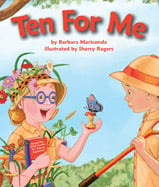Alignment to Standards for DC

| Grade | Number | Standard |
|---|---|---|
| 1 | SC.1.1.7. | Describe and compare objects in terms of number, shape, texture, size, mass, color, and motion. |
| 1 | SC.1.4. | Different types of plants and animals inhabit the Earth. |
| 1 | SC.1.4.1. | Explain that most living things need food, water, and air. |
| 1 | SC.1.4.2. | there can be differences, such as size or markings, among the individuals within one particular plant or animal group (e.g., maple trees, zebras). Variation is a normal characteristic of many kinds of living things. |
| 1 | SC.1.4.4. | animals and plants are living things that grow, reproduce, and need food, air, and water. |
| 2 | SC.2.6. | Plants and animals have structures that serve different functions in growth, survival, and reproduction. |
| 2 | SC.2.6.1. | visible, external features of plants and animals and describe how these features help them live in different environments. |
| 2 | SC.2.7.1. | Observe and describe how animals may use plants, or even other animals, for shelter and nesting. |
| 2 | SC.2.7.3. | plants and animals both need to take in water, animals need to take in food, and green plants need light. |
| 2 | SC.2.7.4. | materials in nature, such as grass, twigs, sticks, and leaves, can be recycled and used again, sometimes in different forms, as birds do in making their nests. |
| 2 | SC.2.8. | Many different types of plants and animals inhabit the Earth. |
| 2 | SC.2.9.2. | Explain that humans, like all living things, reproduce offspring of their own kind. |
| 2 | SC.2.9.3. | Observe that and describe how offspring are very much, but never exactly, like their parents and like other offspring of the same parents. |
| 3 | SC.3.5.1. | living things can be sorted into groups in many ways using various properties, such as how they look, where they live, and how they act, in order to decide which things belong to which group. |
| 3 | SC.3.6. | Plants and animals have predictable life cycles. |
| 3 | SC.3.6.1. | Recognize that plants and animals go through predictable life cycles that include birth, growth, development, reproduction, and death. |
| 3 | SC.3.6.2. | Describe the life cycle of some living things, such as the frog and butterfly, including how they go through striking changes of body shape and function as they go through metamorphosis. |
| 3 | SC.3.6.3. | Compare and contrast how life cycles vary for different living things. |
| 3 | SC.3.7.1. | Explain that people need water, food, air, waste removal, and a particular range of temperatures, just as other animals do, although different animals can tolerate very different ranges of temperature and other features of their surroundings. |
| 3 | SC.3.7.4. | Recognize that food provides energy as well as materials for growth, maintenance, and repair of body parts. |
| 4 | SC.4.7. | All organisms need energy and matter to live and grow. |
| 4 | SC.4.7.1. | Explain that organisms interact with one another in various ways, such as providing food, pollination, and seed dispersal. |
| 4 | SC.4.7.7. | Explain how in all environments, organisms grow, die, and decay, as new organisms are produced by the older ones. |
| 5 | SC.5.8. | Many characteristics of an organism are inherited from the parents, but others result from the influence of the environment. |
| 5 | SC.5.8.2. | List some characteristics of plants and animals that are fully inherited (e.g., form of flower, shape of leaves) and others that are affected by the climate or environmental conditions (e.g., browning of leaves from too much sun, language spoken). |
| 5 | SC.5.9.7. | Recognize that some behaviors are instinctive (turtles burying their eggs) and others learned (wolfês hunting skills). |